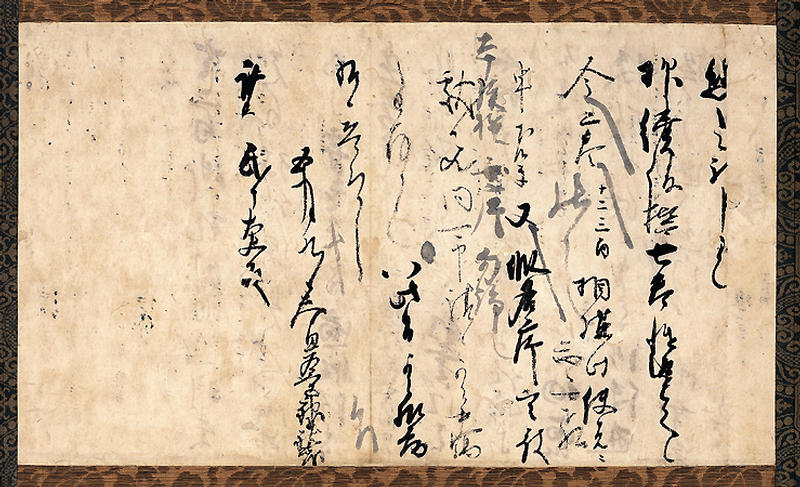Kanpenjo Correspondence between Nakatomi no Sukesada and Fujiwara no Tameie
- Kamakura period
- 13c
- Hanging scroll, ink on paper
- H-27.9 W-47.8
Catalogue Entry
Nakatomi-no-Sukesada and Fujiwara-no-Tameie
Kamakura period, 13th century
Hanging scroll, ink on paper
Height, 27.9cm; width, 47.8cm
Nakatomi-no-Sukesada (1198-1269) was the fourth head priest (Chidori family) of the Kasuga Wakamiya Shrine. He was the leader of the Nanto Nara poetry circle. Sukesada was an imperially nominated poet and was an accomplished researcher who, along with the Kanto priest Senkaku, worked on the Man'yoshu. Using the backs of the kaishi paper used at Kasuga Shrine horaku poetry meetings, or Kakimotoko gatherings, he copied out the Man'yoshu in 20 volumes in 1243 (Kangen 1). Among these, several were unbound by Lord Maeda of Kaga. These kaishi were then recognized as antique writings, the Man'yoshu texts written on their backs were erased, and they became known as the Kasuga Kaishi. This Man'yoshu (fragment) was noted and introduced as the Kasuga version of the Man'yoshu. Prior to this work, Sukesada had copied the Waka shikiyo in 1238 (Katei 4), and then in 1250 (Kencho 2), he edited the Koyuryaku ruijusho (ruibetsu type of Man'yoshu, 12 volumes), and in the 4th month of that same year copied out the Gosenwakashu (the Dai Nakatomi-no-Kiyosuke version in the Tottori Prefectural Library). In his later years, he took the name Sukeshige and wrote his own selection under the title of Zokugosenshu. A number of autographed texts by Sukesada are said to remain. While his signature is rare, there are several examples of his kao (written seal) remaining, but as these were copied by the various generations of Kasuga priests, Sukesada's production was not remarkable, and the calligraphers of the above noted works remain unknown. Sukesada became interested in Man'yoshu research at an early age, copying out the Man'yoshu and also copying out other poetry texts as reference materials. The kanpenjo correspondence with Fujiwara-no-Tameie regarding the loan of the Zokugosenshu served to honor Sukesada. Tameie was the heir of Sadaie, and the Zokugosenshu was selected in 1251 (Kencho 3).
Here Tameie added his comments and response to the letter written by Sukeshige and then returned the letter to Sukeshige. This kind of response written directly on a letter is known as a kanpenjo. The name used in the address is Minbu-no-daibu, the steward of the Mikohidari family (Nijo family). The letter is written in the formal style of hirojo addressed to a member of the aristocracy.
The loan of the Zokugosenshu was divided into 2 or 3 exchanges. He asks whether or not there is a kana version explication included, and given that the explication for this Zokugosenshu was written in 1251 (Kencho 3), it is apparent that this kanpenjo was written immediately after that date. This then further confirms that Sukesada had changed his name to Sukeshige during the Kencho era. FN
